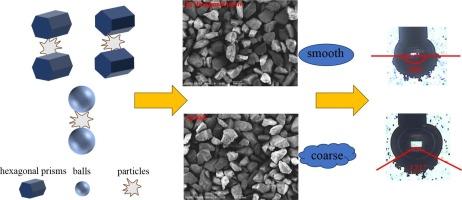Impact of grinding media shape on the dissociation characteristics and flotation behavior of coking coal middlings
IF 4.6
2区 工程技术
Q2 ENGINEERING, CHEMICAL
引用次数: 0
Abstract
The effective dissociation of feed materials has a major impact on the mineral flotation recovery performance in the mineral processing field. Coking coal middlings is difficult to be effectively dissociated due to its complex internal gangue distribution characteristics. The aim of this paper is to compare and evaluate the performance of ball versus hexagonal prism media for the coking coal middlings comminution by point contact and line-surface contact. The results of the grinding tests show that hexagonal prism could result in a more uniform coal particle size distribution, less over-grinding and better selective dissociation effect comparing with ball. The results of the particle shape coefficient indicate the hexagonal prism milled product has a sphericity (Rs) of 0.90 and an elongation (EW) of 1.69, which is more slender than the ball milled product (Rs = 0.94, EW = 1.47). Flotation tests showed that the hexagonal prism milled product was more hydrophobic with a wrap angle of 185° compared to the ball milled product at 121°. Meanwhile, the TSI value of the hexagonal prism milled product is 80.500, which is lower than the 82.608 TSI value of the ball milled product, indicating that the flotation system of the hexagonal prism mill product is more stable. Under the same flotation test conditions, the combustible matter recovery rate of the hexagonal prism milled product was 5.08 % higher than that of the ball milled product.

磨矿介质形状对焦煤煤泥解离特性和浮选行为的影响
在选矿领域,给矿物料的有效解离对矿物浮选回收性能有重大影响。焦煤中矿由于其复杂的内部矸石分布特性,很难被有效解离。本文旨在通过点接触和线-面接触两种方式,比较和评估球形介质与六棱柱介质在焦煤中矿粉碎中的性能。碾磨试验结果表明,与球相比,六棱柱能使煤的粒度分布更均匀,过磨更少,选择性解离效果更好。粒形系数结果表明,六方棱柱研磨产品的球形度(Rs)为 0.90,伸长率(EW)为 1.69,比球磨产品(Rs = 0.94,EW = 1.47)更细长。浮选测试表明,六棱柱研磨产品的疏水性更强,包角为 185°,而球磨产品的包角为 121°。同时,六方棱柱磨产品的 TSI 值为 80.500,低于球磨产品的 82.608 TSI 值,表明六方棱柱磨产品的浮选系统更稳定。在相同的浮选试验条件下,六方棱柱磨产品的可燃物回收率比球磨产品高 5.08%。
本文章由计算机程序翻译,如有差异,请以英文原文为准。
求助全文
约1分钟内获得全文
求助全文
来源期刊

Powder Technology
工程技术-工程:化工
CiteScore
9.90
自引率
15.40%
发文量
1047
审稿时长
46 days
期刊介绍:
Powder Technology is an International Journal on the Science and Technology of Wet and Dry Particulate Systems. Powder Technology publishes papers on all aspects of the formation of particles and their characterisation and on the study of systems containing particulate solids. No limitation is imposed on the size of the particles, which may range from nanometre scale, as in pigments or aerosols, to that of mined or quarried materials. The following list of topics is not intended to be comprehensive, but rather to indicate typical subjects which fall within the scope of the journal's interests:
Formation and synthesis of particles by precipitation and other methods.
Modification of particles by agglomeration, coating, comminution and attrition.
Characterisation of the size, shape, surface area, pore structure and strength of particles and agglomerates (including the origins and effects of inter particle forces).
Packing, failure, flow and permeability of assemblies of particles.
Particle-particle interactions and suspension rheology.
Handling and processing operations such as slurry flow, fluidization, pneumatic conveying.
Interactions between particles and their environment, including delivery of particulate products to the body.
Applications of particle technology in production of pharmaceuticals, chemicals, foods, pigments, structural, and functional materials and in environmental and energy related matters.
For materials-oriented contributions we are looking for articles revealing the effect of particle/powder characteristics (size, morphology and composition, in that order) on material performance or functionality and, ideally, comparison to any industrial standard.
 求助内容:
求助内容: 应助结果提醒方式:
应助结果提醒方式:


